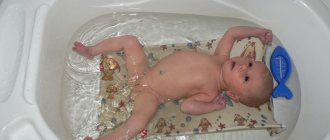Most mothers try natural feeding while in the hospital. It is advisable to give your baby breastfeeding within the first 60 minutes after birth. Experienced midwives help attach the baby and talk about the peculiarities of feeding. If you haven’t immediately figured out how to properly feed your newborn with breast milk, there’s nothing wrong with that. You can master breastfeeding with simple tips.
Benefits of breastfeeding
It is considered great luck if a woman produces enough milk after childbirth. It is an ideal food for a newborn.
Benefits of breastfeeding:
- presence of a balanced composition;
- forms normal intestinal microflora;
- well absorbed;
- practically does not cause allergies;
- promotes the development of immunity;
- has a comfortable temperature;
- protects against infections.
Breastfeeding promotes emotional bonding between mother and baby.
The benefits of breastfeeding at Dr. Komarovsky’s school:
How to breastfeed your baby correctly: instructions
There is nothing more natural and at the same time unique than breastfeeding. It is this that provides the baby with everything necessary from the first hours of life and establishes the psycho-emotional contact between mother and child, which is so necessary for both of them. This connection is a kind of continuation of the one that was carried out through the umbilical cord for all 9 months - it has been proven that breast milk even tastes like amniotic fluid to the baby.
More recently, 20-30 years ago, many young mothers were often forced to give up breastfeeding, and the most common reason for such a radical step was a simple lack of information. Fortunately, today you can easily learn how to breastfeed your baby correctly and establish invaluable contact with your baby even in the most difficult cases.
The foundations for successful future breastfeeding are laid immediately after birth, during the first time the newborn is applied to the breast. It is very important that the baby receives colostrum - yellowish nutritious drops that are secreted by the mother in the first few days. The significance of these applications is, without exaggeration, enormous:
- Colostrum contains immunoglobulins and toxoids, which will protect the baby from viruses, forming his first immunity;
- it is early feeding that helps populate the baby’s intestines with beneficial microflora, which will subsequently protect him from colic and become the basis for the proper functioning of the gastrointestinal tract;
- Colostrum has increased nutritional value. Even a few drops are enough for the baby to be satisfied and fall asleep peacefully, restoring strength after birth.
Thus, it is in the maternity hospital that the foundation of proper feeding occurs, but at the same time, most mistakes are made right there. Inexperienced mothers are embarrassed by the small amount of colostrum, and newborns often refuse to breastfeed. Do not panic!
- A newborn does not abandon the breast, he just quickly fills up, since colostrum is very high in calories;
- It is difficult for a baby to constantly be at the breast and make sucking movements, because these actions require skill. Children weakened during childbirth may simply not have enough strength to produce milk on their own. After the baby sleeps, he will get down to business with great zeal, so do not rush to bottle feed your baby.
It is this kind of “help” that most often becomes the reason for the lack of breastfeeding in the future. The child understands that it is much easier to extract the mixture from a bottle, since with a simple press with the gums a generous stream immediately enters the mouth. When sucking from the breast, a completely different scheme works - milk needs to be extracted, but the baby is lazy and capricious, remembering the experience with the bottle. Gradually, the mother gives in, and feeding through the nipple completely replaces latching.
Many people do not know that not only successful breastfeeding, but also the baby’s well-being depends on how to feed the baby. It turns out that if he does not grasp the nipple correctly, he swallows air along with the milk, which can then cause excessive regurgitation and increased gas formation in the intestines. Pay attention to the feeding process, ideally it should look like this:
- The baby's nose is pressed tightly to the chest. Don’t worry, children are comfortable in this position and can breathe, since the structure of their nasal passages is slightly different from adults;
- By opening his mouth, the baby grasps the entire areola and nipple. The correct grip is easy to determine by the baby’s lower sponge - it turns outward, contact with the mother’s skin is close and complete;
- During the sucking process there is no “slurping”, only the sounds of swallowing are heard;
- Mom does not experience any pain. The exception is the first attachments in the maternity hospital. The delicate skin of the nipple is sometimes not ready for “grinding” by children’s gums. But this pain goes away within a few days.
The main thing is that mother and baby feel comfortable. There are many poses, even exotic ones like hanging over a baby or standing. The main thing is that it is safe and convenient. The following positions are mainly practiced:
- Traditional sitting pose, or “cradle”. It is suitable for both newborns and older children and consists of holding the baby on the elbow “belly to stomach.” Breasts can be alternated by transferring the baby's head from the right hand to the left.
- Lying position from under the arm. This position is suitable for women who have had a caesarean section or those who are prohibited from sitting down after childbirth. The mother lies on her hip, leaning on her forearm, with the palm of her free hand she directs the baby's face to her chest. To prevent the newborn from rolling away, make a cushion out of a diaper and place it under his back.
- Lying position on the arm. This position is practiced by mothers who prefer to fall asleep with their baby at their side. It is no different from the previous one except for the position of the hand. If earlier it acted as a support, now you can relax and lie on it.
- Lying position, feeding from the upper breast. It is convenient because if you need to change breasts, you do not need to disturb the baby and shift with him to the other side.
- Many people like the position in which the baby lies on the mother’s stomach. It saves when very little time has passed after birth and lactation has not yet established. The flow of milk flows like a fountain from the chest and in the usual position the children choke, but this position of the mother allows the baby to easily cope with the flow.
To make feeding easier, buy a special pillow at a baby store - this simple invention will make your life much easier in the first months.
Another reason for parents to worry is whether it is possible to breastfeed at high temperatures. If the fever is not associated with milk flow, then most likely this condition is of viral origin. This means that even before the appearance of external signs - chills, cough or sore throat, the mother has already encountered the virus and is its carrier for several days.
During this time, the body managed to produce antibodies, which are passed on to the baby along with the milk. This is why young children almost never become infected from their mother when they are breastfed - they are protected by their mother's immunity. Even if the disease does appear, the baby will experience it in a mild form.
If you imagine a situation where, due to a rise in the mother’s temperature, the child is abruptly weaned off the breast, then it is easy to imagine the consequences of such a step for the mother’s body. Firstly, this is fraught with the occurrence of mastitis, which, in turn, provokes a new jump in temperature. In addition, a baby who is switched to formula loses the protection of maternal antibodies and becomes vulnerable to viruses.
Consult your doctor: there are many drugs that are compatible with breastfeeding, for example, ibuprofen, paracetamol, etc. If the disease requires treatment with antibiotics, then, regardless of body temperature, feeding will have to be temporarily interrupted. In any case, all these decisions should be made by a specialist.
Until what age should a child be breastfed - this controversial issue causes numerous debates to this day. There is an opinion that we have developed over decades and the official position of the World Health Organization. They are diametrically opposed and here's why:
- According to the theory expressed by most domestic pediatricians, breastfeeding can be stopped when the child reaches 6 months. This is associated with the fact that the baby begins the period of first feeding. In order to ensure a healthy appetite for the future, you need to accustom him to adult food, replacing him with complementary foods at least one feeding per month.
- WHO refers to scientific data, proving that even after a year, the composition of breast milk is rich in useful elements necessary for the development of the baby. This is, for example, vitamin A, on which the correct formation of the visual organs depends, and so on. In addition, there is evidence that children who grew up with prolonged breastfeeding begin to speak earlier and more clearly, since in the process of sucking they constantly develop their speech apparatus. And finally, after two years, natural self-weaning occurs. It does not traumatize the child’s psyche, unlike forced separation from the breast at an early age.
Thus, when deciding on the duration of breastfeeding, we must start from whether refusal will harm the nursing mother and child. If both are physically and emotionally ready for such a step, then you can complete this difficult, but so necessary and pleasant stage of life for every mother.
Basic tips for a nursing mother
Even if there is enough milk, certain rules must be followed to properly feed the baby.
First application
Lactation depends on how quickly the newborn’s first attachment to the breast occurred. This is still an unusual action for him, and the mother or midwife herself should help him do this.
It may only last a couple of minutes. Such hard work quickly tires the baby and he falls asleep.
At the first feeding, the newborn does not receive full milk, but colostrum. It contains many antibodies that protect against infection.
The first application can be called a kind of vaccination. Only a doctor can cancel it for good reasons.
How to prepare your breasts for feeding
You cannot start preparing your breasts during pregnancy. This can trigger premature birth.
Breastfeeding will be difficult if a woman has flat or inverted nipples.
It is recommended to do the following exercises:
- grab the nipple with your fingers and begin to pull them slightly;
- roll them between your fingers;
- make light pinching movements.
It is advisable to use a contrast shower. To make the nipple a little rougher, you can put canvas rags in your bra. An important factor is maintaining personal hygiene.
How to properly latch on to your baby
Breastfeeding should be comfortable. This will contribute to better emotional contact.
To do this, you must follow the rules for attaching a newborn to the mother’s breast:
- choose a comfortable position;
- the mother can lie down, but the baby must be placed on his side;
- the child’s body position should be level;
- You can’t put pressure on the head, you just need to hold the back and shoulders.
If the baby is capricious, you should calm him down before starting feeding. You can experiment with different positions and observe your baby's behavior to find the position that works best for him.
Night feedings
Despite the fact that waking up at night is tiring for a woman, it should be understood that regular feeding is beneficial for the formation of the newborn’s body.
There is no need to specifically wake up the baby, but if a hungry cry is heard, you need to feed the baby. This regime will contribute to the development of emotional stability, which will play a positive role in later life.
It is important for the mother to empty her milk ducts regularly. Despite the fact that some of them occur at night, normal lactation will be ensured precisely with this regimen.
Pumping
To prevent stagnation in the milk ducts, which can cause serious illness, if emptying is incomplete, it is necessary to express the remaining milk.
Carrying out this procedure:
- clasp your chest, leaving your thumb on top;
- Use your remaining fingers to hold your chest from below;
- Grab the nipple and adjacent part of the areola with your thumb and index finger;
- begin massage movements in which the fingers move towards the nipple.
With proper pumping, lactation will improve, and milk will begin to flow out of the breast in streams, emptying it.
Which pose should you choose?
Before you put your newborn to your breast for the first time, you need to find a position in which you can spend half an hour without discomfort. You have 3 options:
- sitting;
- standing;
- lying on your side.
Most women choose a lying position for the first feeding, since after childbirth it is almost impossible to remain in an upright position for a long time. Until complete recovery, you need to feed the baby while lying on your side to protect yourself from unpleasant sensations. If you choose this option, then check out how to properly position your newborn for feeding while lying on his side:
- Release your chest on the side you are lying on.
- Place your baby with his stomach facing you so that his head is against his chest.
- Bring the nipple to the baby's mouth, he will immediately try to take it. When sucking, the entire areola should be in the baby’s mouth, which means that it is captured correctly.
A sitting position is comfortable. This position allows mothers to feed two babies at the same time. In the maternity hospital, this position can be uncomfortable, since you will have to keep your arms suspended on the bed, and there will be no support for your back. If you have a spacious chair at home, then feed the baby while sitting in it, placing your hands on the armrest.
While sitting, two infants can be fed at the same time, placing them on a special pillow in the “under-arm” position.
The standing pose is rarely used, as it puts too much stress on the spine and arms. It is used only by women who have had stitches in the perineum after natural childbirth. They need to lean on the table to reduce the load on the spine and legs. At the first opportunity, the position is changed. It is also recommended when the baby does not latch onto the breast correctly while lying on a bed that is too soft or uncomfortable.
A light massage of the mammary gland using circular movements will ensure a flow of milk.
Questions about organizing breastfeeding
Breastfeeding is an event that needs to be carefully thought through. The health of the baby and his mother will depend on its proper organization.
How to feed on demand or schedule
The latest recommendations from pediatricians suggest that it is more correct to feed on demand. The child cannot yet voice his condition and expresses it by screaming.
This may be not only hunger, but also the need to calm down in the only way available to him - contact with his mother. Frequent latching on demand satisfies both of these needs.
Regular feeding may be forced, for example, if the mother goes to work early.
Choking while breastfeeding
Heavy lactation can result in feeding difficulties. The milk begins to flow in such a strong stream that the child cannot cope with it.
There may be several reasons:
- “weak nipples” in a woman;
- too much milk has accumulated;
- incorrectly chosen pose;
- a long break when the baby greedily swallows without having time to swallow.
To prevent this situation, you need to express some milk before feeding. You can also purchase special pads at the pharmacy.
Baby's refusal to breastfeed
The baby cannot consciously refuse feeding yet. The likely reason is that he is not feeling well.
This can also happen when breastfeeding is supplemented with complementary foods. It is much easier to suck from a bottle and the baby began to prefer this type of saturation.
A child can be weaned from the breast if the mother is absent for a long time, when he becomes weaned from her.
Restless behavior
A baby's anxiety is not always explained by insufficient milk.
The baby may be nervous because the mother has flat nipples and finds it difficult to grasp them. Another reason may be an uncomfortable posture. Digestive problems, reflux, increased gas formation do not contribute to a good mood.
You should try to change the position and do not forget to hold the baby in a “column” after feeding so that the air swallowed along with the milk comes out.
How to tell if your baby is full
You should purchase a scale and weigh the baby after each feeding. There are standards for how much he should suck at different ages at a time. Normal lactation will allow you to meet this target.
After proper nutrition, the breasts become empty and softer. If the baby is full, it will be noticeable by his happy appearance.
If mom is sick
If the mother has a common cold, this is not a reason to stop breastfeeding. In case of close contact, wear a gauze bandage.
It’s another matter if diseases such as tuberculosis are detected. Different approaches are possible for different diseases. Weaning may be temporary until cured. For some diseases, milk is expressed, pasteurized and fed from a bottle.
Bad habits
What a woman could afford before she knew that she would become a mother should be stopped from the very beginning of pregnancy.
First of all, this applies to smoking and drinking alcohol. These restrictions must also be observed when breastfeeding.
Baby feeding time
The question of the time of each meal cannot be resolved unambiguously. The duration of one feeding session depends on the individual characteristics of the child. Some babies eat actively and quickly, so only 10 minutes are enough for them to be satisfied. Other kids enjoy the process for a long time; it takes them more than 40 minutes. In the first month of life, you should not interrupt feeding yourself. Gradually, the newborn will adjust the duration of sucking.
Experts consider a feeding session lasting up to 30 minutes to be correct. It may last longer if the baby is premature or weakened. If the baby falls asleep with the breast in his mouth, then you just need to release the nipple and transfer it to the crib. For newborns, sleeping after feeding is considered normal.
If you are interested in the total duration of breastfeeding, then it is selected individually. You should stop breastfeeding after one year. After the first 6 months of life, you can gradually replace feedings with complementary foods, which will prepare the baby’s digestive system to accept normal food, and the mother will gradually reduce lactation.
It is important not only to know how to breastfeed, but also to learn how to maintain time intervals. Doctors recommend applying the baby hourly, but it is best to do it on demand. Breaks can be from 15 minutes to 2 hours, and during night sleep the interval increases. If the baby is calm and does not require breastfeeding, then after 3-4 hours you should independently offer him something to eat. Don't wake your baby to breastfeed. A well-fed baby will not sleep peacefully; he will independently demand food.
Breast problems during feeding
When breastfeeding, a woman's breasts are subject to constant mechanical stress. This does not always go unnoticed.
Breast problems vary in severity.
Cracked nipples
Cracks in the nipples – damage to the integrity of the delicate skin. This causes pain when feeding. Infection can penetrate through the wounds, which will worsen the situation. When feeding, there is a danger of infecting the baby.
Women with inverted nipples, sensitive skin, and weakened muscles are predisposed to the appearance of cracks.
The main reason is the baby’s insufficient latching on to the breast. When grasped correctly, the nipple is secured with the lower lip tucked in. Investing at insufficient depth contributes to injury.
The second reason may be improper weaning after feeding. During this stage, it is necessary to support the baby's head. He may turn away while still holding the nipple in his mouth. Sometimes the mother herself tries to pull out the nipple, but the child continues to pinch it.
You should not remove the breast from your baby if he is still holding it. It is quite possible that he is not yet full. If you lightly shake the baby, who is overwhelmed with pleasure and has closed his eyes, he can continue to suck until the nipple falls out of his mouth.
Correct behavior when feeding: hold the baby with his stomach towards you, supporting his head. If it is necessary to interrupt feeding, insert a clean little finger between the slightly open jaws and carefully remove the breast.
Another reason could be washing your nipples too often. This washes away the natural lubricant and reduces the protective effect. Constantly wearing pads on the chest leads to skin irritation.
When feeding children who are already teething, biting is possible. Cracks may appear when expressing with a breast pump.
To heal cracks, you can apply vitamin E or sea buckthorn oil to your breasts. Once dry, there is no need to rinse them off. Special ointments are used to promote healing. Physiotherapy may be used.
To reduce skin sensitivity, it is possible to use a contrast shower and massage. This can be done for prevention during the last period of pregnancy.
Lactostasis
Lactostasis is stagnation of milk as a result of blockage of the milk ducts. As a result, inflammation appears and pain occurs. The chest swells. The temperature rises.
Violations are detected in the first days after the start of feeding. After a couple of months, lactation improves. But, if measures are not taken, a complication in the form of mastitis may occur.
One of the possible causes of lactostasis is a structural feature - too narrow milk ducts. Because of this, the baby is unable to completely empty the breast of milk. As a result, he does not eat completely, and the chest does not empty completely.
Lactostasis can be caused by a poorly chosen bra that puts too much pressure on the breasts. Putting your baby to the breast on a schedule with long breaks can also cause the disease. Severe hypothermia is undesirable.
The main symptom of lactostasis is redness in the area where milk stagnation occurred.
Effective measures for the treatment of lactostasis are expressing after feeding and breast massage. If you have a fever, you can take paracetamol. If symptoms do not go away, antibiotics are prescribed.
Mastitis
Mastitis is an inflammatory process of breast tissue. It is difficult for women who are breastfeeding.
Its symptoms are:
- breast swelling;
- compaction;
- increase in breast size;
- redness of the skin;
- bursting pain;
- rise in temperature;
- chills;
- general malaise.
Mastitis can be diagnosed by visual examination. An ultrasound will provide more reliable results.
Consultation with a doctor and diagnosis of the disease is necessary, since the severity of the disease requires the use of antibiotics. Not all of them are suitable for nursing mothers.
Mastitis is caused by infection. In nursing mothers, it is preceded by a long-term effect of lactostasis. When the skin in the mammary gland area is damaged, bacteria easily enter there, creating a favorable environment for their reproduction.
Since breast milk is contaminated, breastfeeding should be stopped. During treatment, you can express it, pasteurize it and give it to your baby from a bottle.
Prevention of mastitis is complete emptying of the mammary glands. You should alternate breasts when feeding.
Regular self-examination is necessary. If cracks appear, treat them immediately.
How can you tell if your baby is full?
In addition to knowing how to properly attach a baby to the breast, mothers need to receive information about the signs of satiety of the baby. After all, it is very easy to overfeed a baby, for whom every feeding session is an opportunity to feel the protection and support of the mother.
The baby is full if he:
- behaves calmly;
- cheerful after the process is completed;
- gains sufficient weight according to WHO standards;
- released the breast on his own;
- After feeding, he falls asleep soundly or goes on to active activities.
If a newborn is often capricious, anxious, or crying, then before giving him both breasts at one feeding, it is necessary to carry out a control weighing. It is held once a week. If, after a seven-day period, the child’s weight has become higher, it is necessary to look for another reason for crying.
https://youtu.be/lxRMtD7vYUs
Signs of overeating are:
- regurgitation after feeding;
- rapid weight gain exceeding established norms;
- increased gas formation, leading to colic and abdominal pain.
Regurgitation can be a sign of a neurological disorder, so it is important to monitor the child’s health and visit doctors in a timely manner. If your pediatrician notices signs of overeating in your baby, release the nipple 15-20 minutes after the start of feeding. When overeating, do not try to reduce lactation, this often leads to its complete loss.
Diet of a nursing mother
Breast milk contains both nutrients and toxins. Therefore, a nursing mother must adhere to a certain diet.
The most strict diet must be followed in the first time after childbirth, while the newborn’s gastrointestinal tract adapts to process food. The mother's nutrition during this period should be given special importance.
In the first week it is recommended to consume:
- vegetable soup;
- vegetable stew;
- low-fat fermented milk products;
- cottage cheese;
- porridge cooked in water;
- lean dietary meat.
You can drink water and weak tea.
Priority when preparing food should be given to boiling, stewing, and steaming. Fried, smoked, and canned foods should be excluded.
Despite the fact that the food should be dietary, it should be structured so that the nursing woman receives substances that help restore the body.
Authorized products:
- lean meats - veal, chicken, turkey;
- fish is an essential component of the diet, providing the body with protein;
- porridge from cereals of all varieties;
- fermented milk products – fermented baked milk, kefir, yogurt, yogurt;
- sour cream, butter - in small quantities;
- milk - no earlier than 4 months, when cooking porridge with it;
- lightly salted cheeses;
- chicken eggs in small quantities, starting no earlier than 3 months;
- fruits, giving preference to bananas, apples, pears;
- cooked vegetables;
- bakery products, excluding fresh baked goods;
- pasta;
- nuts;
- fresh herbs.
Spices, onions and garlic are best avoided as they can change the taste of breast milk. When introducing new dishes, you should monitor your baby. If any allergic reactions occur, stop using this product.
The most preferred drinks are: green and weak black tea, dried fruit compotes and berry fruit drinks.
What not to do?
If you know how to attach your baby when feeding, this does not mean that you do not have other questions. The process of breastfeeding is very complex, and young mothers often make mistakes that negatively affect the lactation process.
- Breast washing should be done in moderation. If you wash your nipples before each application, you will get rid of the protective lubricant. In addition, soap can dry out the skin, which can lead to cracked nipples. It is enough to perform hygiene procedures in the morning and evening.
- During feeding, you cannot support the breast; it must lie freely, otherwise stagnation of milk may form at the point of contact with the hand. For the same reason, it is forbidden to wear bras with underwires: choose soft textile options for nursing mothers that will not crush the milk ducts and will not cause lactostasis.
- Breastfed babies should be given water only after complementary feeding has been introduced. Until this moment, milk will replace his food and drink.
- You should not give artificial formula if you have a cold or cracked nipples. It has been proven that it is necessary to feed your baby during colds. Natural nutrition allows babies to develop antibodies to the bacteria or virus that caused them. If you are afraid of infecting your child, wear a mask. If cracks occur, feed the baby through the pads.
- Give the baby pacifiers or feeding porridge from bottles. A pacifier does not help solve the problem of how to properly attach a baby to the breast; often after it, babies begin to latch onto the nipple incorrectly. It is easier to get food from a bottle, so often when using it, babies refuse natural nutrition.
- Stop feeding after the first tooth appears. Being bitten is unpleasant, but the baby is unable to seriously injure its mother. Reduce lactation gradually: you should not stop feeding suddenly.
Another mistake is frequent weighing. If the baby slowly gains weight, the mother begins to give him an artificial formula. It acts as additional nutrition or completely replaces natural nutrition. Find out your child’s body weight no more than 4 times a month, then you will be able to objectively assess the changes.










